 Fenix Tours
Fenix Tours

Prices and booking => please, scroll down


A substantial part of the province of Matera is characterized by the presence of extensive erosive phenomena: the badlands. These are slopes sometimes completely devoid of vegetation that take very varied forms depending on the erosive phase.
My passion for the Badlands, beyond the love for my land, began some time ago listening to a phrase on the radio that instantly impressed me: "feeling the presence in the absence". A Milanese poet said this about his land: the Po plain. I was 20 years old and for some time already wandered far and wide the lands of Southern Italy walking through the countryside and the woods. A few years later I chose the study of Badlands for my Bachelor’s thesis in Agricultural Sciences. I felt that presence too, and this same mystical feeling, I felt during my American Ph.D. while studying the desert soils of Nevada.
The presence in the absence. The fogs that do not make you see the landscape as in the case of the Milanese poet there are only during the cold and humid winter days. Instead here is the apparent absence of vegetation, the glow of clay that can sometimes blind, the life that seems not to be there and instead there is...
The flocks of sheep and goats leave traces of their passage along the badlands slopes, and the shepherds sometimes set fire to the bushes to prevent them from taking back possession of the places. And so an almost desert landscape presents itself to the eyes of the traveller. And to make the landscape even more dramatic there are the ghost town of Craco, the ruins of the castle of Uggiano, the solitary Tempa Petrolla, the magic handed down by Carlo Levi on the charming village of Aliano... A landscape that penetrates deeply into the soul. An unforgettable excursion!
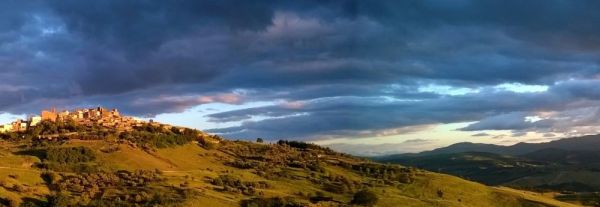

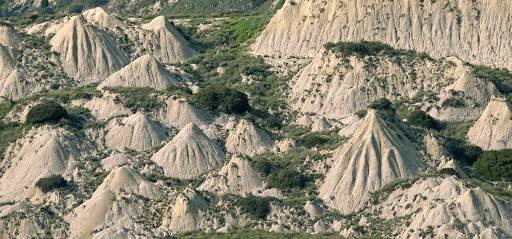
By clicking on the images you open the destination sites
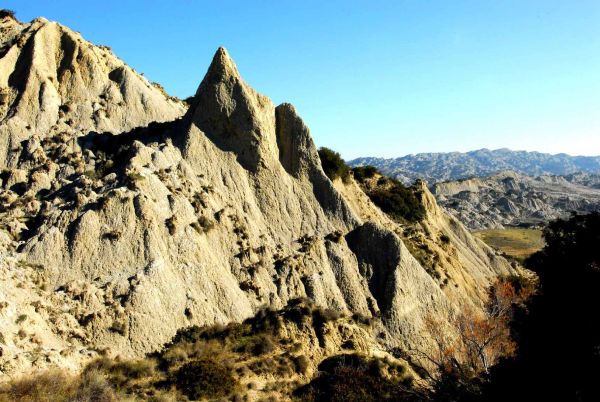
The hilly landscape that surrounds Aliano is so suggestive that it is uneasy to go away without feeling a strong nostalgia. The "Genius loci" pervades the visitor and magically attracts him towards the arid expanses of the desert in search of something moving, a noise or a remote echo. Only the attentive eyes of the black kite gliding over the gorges and clay hideouts break the badlands stillness and invite the gaze to space out distant horizons and the white houses clinging on the ravine crests.
Levi “… The house where finally a few days later ... I went to live was, it can be said, the only civilian house in town... It was made up by three rooms, one in a row to the other. From the street, a side alley on the right of the main street, it was the kitchen, from the kitchen to the second bedroom, with five windows, which was my living room and my painting studio ".
From Levi's writings an empty, uninhabited house, as it is nowadays, inhospitable, almost hostile as he left it after his departure, gradually come back to life. The restoration of the house intends to make it accessible and allow a discreet and delicate intrusion but not modifying or offending what Levi observed, studied and commented on. A house somehow trivial, but with the magic that only places that have entered a great novel are enough lucky to convey.

'Christ never arrived here, nor did time arrive, neither the individual soul, nor hope, nor the link between causes and effects, reason and history', wrote Carlo Levi about this region which at that time was called Lucania.
Today, as then, Basilicata has its roots and its history between mountains and sea, between barren panoramas and forgotten peasant worlds. In a ghostly landscape consisting of badlands, among structures and buildings in ruins, on a slashed and eroded land, there is what is left of Craco, the ghost town in the province of Matera,391 meters above sea level. The village survived for a thousand years on a rock spur overlooking the valley of Salandrella river, ending up evacuated in 1963, when a landslide, caused by the malfunction of the water system, affected the inhabited center. Since then Craco has stood still over time, definitively fixing that present life until the moment, it stopped being inhabited. It gives the impression of a sculpture of medieval origins surrounded by the "Calanchi".
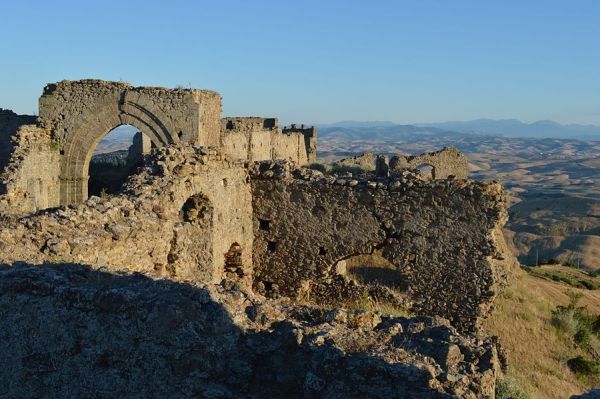
On a clearing of just over one hectare, at the top of a hill with slopes that descend sharply towards the Salandrella valley and the Lavannara canal, the surviving sections of the ruined city wall stand out among the brushwood, in a state of precarious balance and the remains of the square tower which until thirty years ago was framed by an Angevin arch. Today the atmosphere of abandonment, underlined by bushes and thistles that dot the clays of the badlands, takes on an emblematic meaning here. The castle of Uggiano is just one of the many ruins among which we are used to wander in a region of ancient population, where the ruins of Greek and Roman antiquity juxtapose with prehistoric sites and medieval works of fortification justifying the strategic role of Basilicata, give way to the settlements of the following centuries.
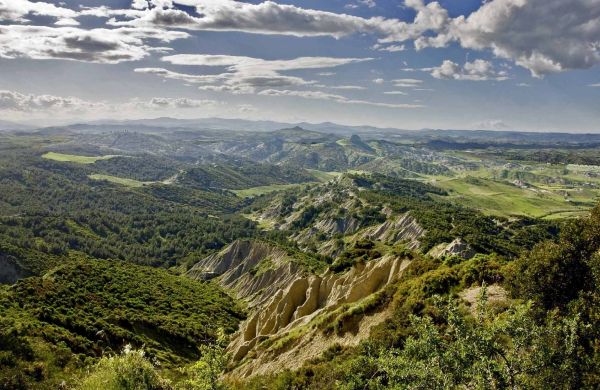
The historical center (Terra vecchia) of Montalbano - a natural point of arrival or departure for excursions or walks into the Reserve - maintains an interesting Roman layout, well-preserved medieval and seventeenth-century walls, several historic buildings and churches. From its belvedere it overlooks the metapontine plain and it is possible to take a glimpse of historical sites from the Hellenistic and Roman period, such as Heraclea and Anglona. The most inaccessible area of the gullies where Montalbano was built, is quite spectacular as well. A visit to the Reserve and the adjacent "Terra Vecchia" of Montalbano, therefore, offers unique, varied and highly suggestive experiences.

Please do not forget to read the Terms & Conditions before booking. The reservation is valid after the payment of the advance or the full amount.
![]() For the same tour there are two prices based on the number of people. For groups of more than 8 people, please contact us.
For the same tour there are two prices based on the number of people. For groups of more than 8 people, please contact us.
 After deciding which excursion you want to do, click on the booking button that will open a partially pre-filled e-mail. You must indicate the tour, the date, the number of participants and your special requests. Probably it will take more than one e-mail to define the excursion but as soon as you receive our confirmation email, you can make the payment (in advance or in full).
After deciding which excursion you want to do, click on the booking button that will open a partially pre-filled e-mail. You must indicate the tour, the date, the number of participants and your special requests. Probably it will take more than one e-mail to define the excursion but as soon as you receive our confirmation email, you can make the payment (in advance or in full).

To make payment after clicking down payment or full payment button, a new window will open with several button

The upper buttons let you choose whether to pay with your Paypal account (if you have one), by credit card or any other online payment method existing in your country that is affiliated with Paypal. This alternative changes depending on the country.



If your currency is not the euro (€), it is advisable to pay via the Wise or XE platforms. Paypal applies commercial exchange rates (those of the bureaus of exchange for example) very unfavorable, while Wise and XE apply the official rates with very low fees. Simply open a Wise or XE account and make the payment via the mobile app or PC by making the transfer to the bank account of Fenix Tours. The bank details will be communicated to you in the confirmation e-mail

The balance can be paid either with Paypal, Wise and XE or at the latest, at the start of the tour by credit card or cash (euro).
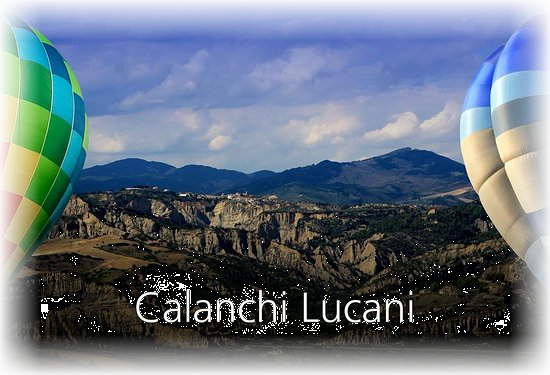
The two most representative places of this excursion are the ghost town of Craco and Aliano, place where the famous book "Christ stopped at Eboli" was set by the writer Carlo Levi. The nearby Regional Reserve of the Badlands with the peculiar Tempa Petrolla as well as Craco dominate the valley of the river Cavone and from their peaks the landscape is absolutely spectacular. You cannot put aside in order to enter the soul of these places (genius loci) the ruins of the Castle of Uggiano near the pretty Ferrandina or even Moltalbano whose gullies show the geological evolution of the last 5 million years of the history of the area.

| 1-3 people | 4-7 people | ||||
| Full Price | Down Payment | Balance | Full Price | Down Payment | Balance |
| 700 € | 210 € | 490 € | 980 € | 294 € | 686 € |

The badlands of Lucania find their best expression in the heart of the province of Matera. The hydrogeological instability of the area is well represented by Craco, a town abandoned a few decades ago following a landslide and for its drama and spectacularity is often used as a setting for films just like the Sassi of Matera. The first visual approach is equally impressive from the beautiful and majestic ruins of the castle of Uggiano that stretch out towards the Cavone valley. Even Uggiano as Craco was a town that according to historical chronicles was abandoned towards the end of the fifteenth century following an earthquake but historians believe that it was a landslide.
The Badlands Regional Reserve is another jewel and very representative of these geological formations. The park flanks the city of Montalbano and walking along the edge of the Ionian town that flanks the badlands, the show is magnificent. The stratigraphy of the geological deposits that have formed in the last 5 million years are all readable and interpretable in this reserve.
Finally moving to Aliano, village in which is set the famous book "Christ stopped at Eboli" in addition to being able to discover other spectacular events of badlands, you enter the magical and ancestral world described by the Turin writer Carlo Levi during his confinement in Aliano in the fascist period.

| 1-3 people | 4-7 people | ||||
| Full Price | Down Payment | Balance | Full Price | Down Payment | Balance |
| 1120 € | 336 € | 784 € | 1568 € | 470 € | 1098 € |